| Designation: | ERC Sagaie |
 |
|---|---|---|
| Manufacturer: | Societe de Constructions Panhard et Levassor | |
| Product type: | Armoured Vehicles | |
| Name: | Reconnaissance Vehicle |
The ERC (Engin de Reconnaissance Canon) range of armoured cars was developed by Panhard as a private venture from 1975 and was aimed specifically at the export market.
The range was first shown in 1977 at the Satory Exhibition of Military Equipment and entered production the following year at Panhard's new factory at Marolles. First production vehicles were completed in 1979.
The ERC range of armoured cars share many automotive components with the Panhard VCR range of armoured personnel carriers also shown for the first time in 1977. Full details of these are given in the Armoured personnel carriers (wheeled) section.
The Panhard VCR (6 x 6) was originally developed to meet the specific operational requirements of Iraq as the platform for the Euromissile UTM-800 HOT anti-tank turret. Using automotive components from the VCR (6 x 6) the ERC armoured car was created but with a different wheelbase on account of the turret basket of the new Giat Industries TS90 turret.
The French Army evaluated the ERC 90 F4 Sagaie between 1978-80 and accepted the vehicle in December 1980 although further trials, including hot weather trials in Djibouti in 1982, were subsequently carried out. First production vehicles were delivered to the French Army in 1984 and the total French Army order was for 192 ERC Sagaies with final deliveries in 1990.
The French Rapid Deployment Force uses this vehicle as its standard armoured car. The 1st Regiment Infanterie de Marine of the 9th Marine Division has converted to a reconnaissance regiment with ERC 90 vehicles. The Regiment d'Infanterie de Chars de Marine of the 9th Marine Division received all of its vehicles in 1984, the 1st Regiment of the Parachute Hussards of the 11th Parachute Division received their vehicles in 1985-86 while the 4th Chasseurs Regiment of the 27th Alpine Division received their vehicles in 1988-89. In each case they replaced Panhard AML 60 and AML 90 (4 x 4) armoured cars. Each regiment has three squadrons with each of these having four platoons each with three ERC 90 F4 Sagaies and a Euromissile MILAN ATGW squad.
A total of 42 ERC 90 F4 Sagaie armoured cars is forward deployed overseas, 24 with the 13th Foreign Legion in Djibouti, six with the 6th Marine Corps Battalion in Gabon, six with the 43rd BIMa in the Ivory Coast and six with the 23rd BIMa at Dakar in Senegal.
The all-welded steel hull provides the crew with protection against small arms fire and shell splinters. The floor of the hull consists of two plates welded together to form a flat V which helps the vehicle to slide off obstacles and stiffens the floor against damage from mines.
The driver is seated at the front of the hull, slightly to the left of the vehicle's centreline. This hatch is in two parts: one part, which contains the forward-facing periscope, folds forward onto the glacis plate and the second part folds upwards. The forward periscope can be replaced by an image intensification periscope for night driving, and there is an additional periscope either side of the driver's hatch cover.
The turret is mounted in the centre of the vehicle and as each version has a different turret they are described in detail under Variants. All vehicles in the range are powered by a militarised version of a Peugeot V-6 petrol engine which develops 145 hp at 5,500 rpm. Power is taken from the engine through a single-plate clutch to a transversely mounted Panhard gearbox with six forward and one reverse gears and incorporating a Panhard cam-type limited slip differential from which the drive is taken to either side of the vehicle. Drive is then taken by half-shafts to bevel gears at the centre wheel stations and then shafts take power to the bevel gears at the front wheel stations. The rear wheel bevel gears are driven by shafts directly from the gearbox. The drive from the centre to the front wheel on each side incorporates another cam-type limited slip differential. Ppwer is transmitted from the bevel boxes to the wheels by a train of gears housed within trailing arms which independently locate the wheels. The front and rear wheels are sprung by single coil springs with concentric telescopic hydraulic dampers. The centre wheels, which are raised off the ground when on roads, are sprung by hydropneumatic units. The centre wheels are powered even when raised clear of the road surface.
Only the front wheels are steered, and steering is hydraulically assisted. The low-pressure tyres are fitted with Hutchinson cellular inner tubes, which enable the vehicle to travel for at least 100 km at 30 km/h when the tyres have been punctured by bullets.
The basic vehicle can ford to a depth of 1.2 m without preparation but two different amphibious models of the ERC have been developed. Both models have a trim vane mounted at the front of the hull which is folded back onto the glacis plate when not in use and which has a transparent panel in its centre to enable the driver to have a clear view ahead, and sheet metal floats over the wheel stations filled with closed-cell foam. A rear opening door is provided in the left side of the hull. Before entering the water the trim vane is erected and the two tubular ducts at the sides of the engine compartment are hydraulically swivelled into the vertical position to prevent water entering the engine compartment. The radiator compartment is allowed to flood, as when the vehicle is afloat cooling is by water-to-water heat transfer. The first amphibious model is propelled in the water by its wheels and the second by two Dowty-Messier hydrojets.
All models have a turret-mounted ventilator and internal lights as standard. Optional equipment includes an NBC system, a ground navigation compass, air conditioning equipment and a front-mounted winch with 60 m of cable and a capacity of 3,500 kg.
- ERC 90 F4 Sagaie (ERC-1 Sagaie)
This was the first model to enter production and is fitted with a Giat Industries TS 90 turret armed with a 90 mm gun which can fire canister, HE, HE long-range, HEAT, smoke and APFSDS ammunition.
A 7.62 mm machine gun is mounted coaxially to the left of the main armament and two smoke grenade dischargers are mounted either side of the turret at the rear. The commander is seated on the left side of the turret and the gunner on the right, both with a single-piece hatch cover that opens to the rear. The commander is provided with seven periscopes and the gunner five; the gunner also has an M563 telescopic sight with a magnification of x 5.9. Of the 20 90 mm rounds carried in the turret, 12 are HEAT and 8 HE.
Panhard offers six options for this vehicle, each with a weight index of 1 or 2, and the user can select options up to an index of 4. The options are: amphibious kit propelled in the water by wheels (1), amphibious kit propelled in the water by hydrojets (2), NBC system (1), air conditioning system/heater (1), an additional 10 rounds of 90 mm and 1,000 rounds of 7.62 mm ammunition (1) and a ground navigation system (1).
- ERC 90 F4 Sagaie 2 (ERC-2 Sagaie)
This model was announced at the 1985 Satory Exhibition of Military Equipment, has a longer, wider hull and is powered by two Peugeot XD 3T four-cylinder turbocharged diesel engines each developing 98 hp at 4,150 rpm. These engines are also used in the Panhard VBL light scout car, the VCR TT 2 APC (two engines) and the upgraded AML/Buffalo 4x4 vehicles. The engines are coupled to a ZF 4 HP 22 automatic transmission with four forward and one reverse gears and a Panhard two-speed transfer box, one for road travel and the other for cross-country.
As an alternative to the two Peugeot XD 3T engines the Sagaie 2 can also be powered by two Peugeot PVR six-cylinder water-cooled petrol engines developing 145 hp each.
The Sagaie 2 has larger 13.00 x 16 tyres compared to the Sagaie 1 which has 11.00 x 16 tyres, and the central pair of roadwheels has been moved further back.
By 1985, two vehicles had been built, one with two petrol engines and one with two diesel engines. The vehicle can be made amphibious by filling the side bins with foam; this also provides some degree of protection against HEAT attack.
The prototypes have been fitted with the SAMM TTB 190 turret which is the model selected by Gabon, but other turrets can be fitted including TS 90.
The desert version has no water-jets for amphibious propulsion and the buoyancy boxes are replaced by boxes for increased stowage of ammunition, fuel and water. Optional equipment includes an NBC system and an air conditioning unit.
The only known customer for this vehicle, which is also referred to as the Panhard ERC-2, is Gabon. SAMM is no longer building or marketing the TTB 190 turret system.
- ERC 90 F1 Lynx (ERC-1 Lynx)
This is fitted with a Lynx 90 turret designed and manufactured by Hispano-Suiza and armed with a 90 mm F1 gun, a 7.62 mm coaxial machine gun and two smoke grenade dischargers on either side of the turret at the rear. The gun fires HEAT, HE, smoke and canister rounds.
The commander is seated on the left of the turret with the gunner on the right. The commander is provided with a cupola with a single-piece hatch cover that opens to the rear and eight periscopes for all-round observation. The gunner is provided with a single-piece hatch cover that opens to the rear. Vision equipment consists of a combined day and night passive periscope Model TJN 2.90 (SOPELEM), TCV 107 laser range-finder (CILAS/SOPELEM) and 12 periscopes (nine Type L794B and three Type L794D). A total of 21 rounds of 90 mm ammunition is carried in the turret and, if required, a 7.62 mm machine gun can be fitted for anti-aircraft defence.
Panhard offers six options for the vehicle, identical to those offered for the ERC 90 F4 Sagaie except that it can carry an additional 20 rounds of 90 mm ammunition rather than the 10 on the ERC 90 F4 Sagaie.
- Other versions of the Panhard ERC
The following versions of this vehicle are no longer being marketed by Panhard: ERC 60/12 Mangouste EMC 81 mm Mortar Gun Carrier ERC with SAMM TTB 125 turret ERC with SAMM TTB 190 turret ERC with 60-20 Serval turret ERC with SAMM S 530 A 20 mm turret ERC with TG 120 turret ERC with TTB 140 40 mm turret ERC with ESD TA-20 turret
ERC with SAMM TAB 220 20 mm turret (this has a two-man turret with twin 20 mm anti-aircraft cannon and four have been sold to Gabon)
- Sagaie upgrade
In 1998, Panhard submitted a proposal to the French DGA for the upgrade of the French Army fleet of Panhard ERC 90 F4 Sagaie (6 x 6) armoured cars fitted with Giat Industries 90 mm TS-90 turret.
The Panhard ERC 90 F4 Sagaie is powered by a Peugeot V-6 petrol engine developing 155 hp coupled to a manual transmission. This gives the vehicle a maximum road speed of 95 km/h with a maximum operational road range of 700 km.
Today these are the only petrol-engined armoured fighting vehicles in service with the French Army which, like most other armies, is now moving to a common diesel fuel policy with the obvious logistical and increased operational range advantages.
The main part of the proposed Panhard upgrade is the replacement of the existing power pack by a new power pack consisting of a more fuel-efficient MTU 4-cylinder diesel developing 170 hp coupled to a Renk fully automatic transmission with torque converter. This maintains road speed at 95 km/h but operational range is increased to 900 km.
The current vehicle weighs 8.3 tonnes and is fully amphibious being propelled in the water by water-jets mounted at the rear of the hull. The upgraded vehicle, with add-on armour, weighs 9.5 tonnes but is not amphibious.
If the go ahead is given some time in 1999, then it is expected that at least one prototype will be completed for trials purposes followed by the award of a production contract with first vehicles entering service around 2002.
Once it has been type classified by the French Army, the repower upgrade will also be offered by Panhard on the export market.
Since it has entered service with the French Army, the Panhard ERC 90 F4 Sagaie has already been upgraded in a number of areas including additional turret armour, increased external stowage and roof skate mount for a 7.62 mm machine gun. Some have also been fitted with a roof-mounted anti-tank missile decoy system.
|
||||||||||||||||||||||||||||||||||||||||||||||||||||||
|
|||||||||||||||
|
|||||||||||||||||||||||||||||||||
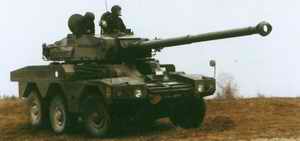 |
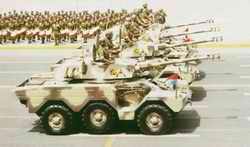 |
 |
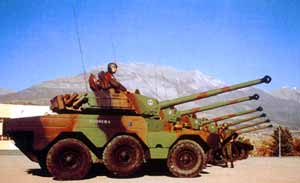 |
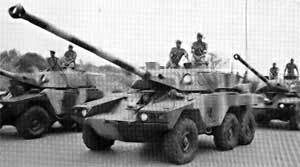 |
 |
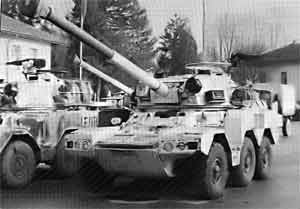 |
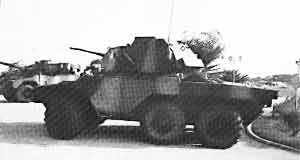 |
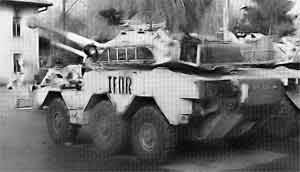 |
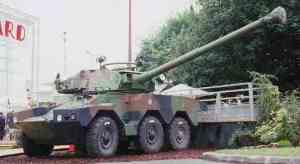 |
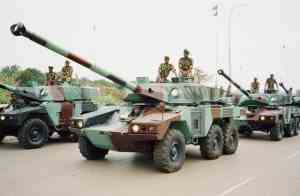 |
 |
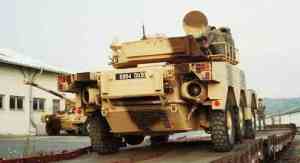 |







